Redgram: Insect and Mite Management
Redgram: Insect and Mite Management
Gram pod borer
BiologyIt is a polyphagous pest, infesting gram, lablab, safflower, chillies, groundnut, tobacco, cotton etc.
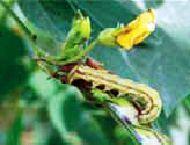 Egg: Spherical, yellowish eggs are laid singly on tender parts and buds of plants. The egg period lasts for 2-4days.
Egg: Spherical, yellowish eggs are laid singly on tender parts and buds of plants. The egg period lasts for 2-4days.- Larva: Caterpillars are of varying colour, initially brown and later turn greenish with darker broken lines along the side of the body. Body covered with radiating hairs. When full grown, they measure 3.7 to 5 cm in length. The larval period lasts for 18-25 days. The full grown caterpillar pupates in the soil.
- Pupa: Pupation takes place inside the soil in an earthen cell. Pupal stage lasts 7-15 days.
- Adult: Moth is stout, medium sized with brownish/greyish forewings with a dark cross band near outer margin and dark spots near costal margins, with a wing expanse of 3.7 cm.
- Defoliation in early stages
- Larva’s head alone thrust inside the pods and the rest of the body hanging out.
- Pods with round holes
- Warm weather conditions followed by light rains and dry spells are favourable for multiplication.
- Parasitoids: Trichogramma spp., Tetrastichus spp., Chelonus spp., Telenomus spp., Bracon spp., Ichneumon spp., Carcelia spp., Campoletis sp etc.
- Predators: Lacewing, ladybird beetle, spider, red ant, dragonfl y, robber fl y, reduviid bug, praying mantis, black drongo, common mynah, big-eyed bug (Geocoris sp), earwig, ground beetle, pentatomid bug (Eocanthecona furcellata) etc.
Spotted pod borer
It is a polyphagous pest, infesting gram, lablab, safflower, chillies, groundnut, tobacco, cotton etc.
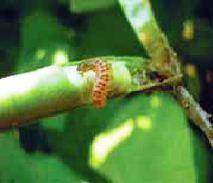 Egg: Eggs are laid on the under surface of leaves, terminal shoots and flower buds. The freshly laid eggs are milky white in colour and oval in outline, dorsoventraly flattened and glued to the surface.
Egg: Eggs are laid on the under surface of leaves, terminal shoots and flower buds. The freshly laid eggs are milky white in colour and oval in outline, dorsoventraly flattened and glued to the surface.- Larva: Larvae are greenish white with brown head. Larval period is 15-20 days
- Pupa: Pupation takes place in dry leaves and debris
- Adult: Adults have brown forewings and white hind wings
- Bore holes on the buds, flowers or pods
- Infested pods and flowers are webbed together
- Parasitoids: Trichogramma spp., Tetrastichus spp., Chelonus spp., Telenomus spp, Bracon spp. etc.
- Predators: Lacewing, ladybird beetle, spider, red ant, dragon fly, robber fly, reduviid bug, praying mantis etc.
Pod fly
It is widely distributed in India and causes major economic losses in northern parts of India causing significant losses especially in long duration varieties. This pest alone accounts for 70-80% of the total pod damage by pod borer complex. The infected seeds do not germinate.
Biology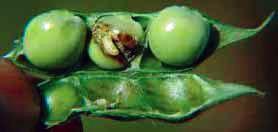 Egg: The adult female oviposits in the tender pods. Eggs measure about 0.97 mm in length and 0.15 mm in breadth.
Egg: The adult female oviposits in the tender pods. Eggs measure about 0.97 mm in length and 0.15 mm in breadth.- Larva: The freshly enclosed maggots are transparent, Mature larvae are white and up to about 3.5 mm long.
- Pupa: Pupal cases are orange-brown, about 3 mm long, with a pair of closely spaced anterior spiracles projecting forward, and a pair of prominently projecting posterior spiracles on tubercles that are joined basally.
- Adult: Both sexes are 2-3 mm long, and may appear black to the naked eye, but the thorax and abdomen have a distinct, green metallic sheen if examined under magnification. The head has a prominent ocellar triangle, also metallic green that extends to the lunule (recessed crescent above the antennae). The wings are clear. The female has an unusually long, black ovipositor sheath.
- Dark brown encrustation on the pod wall
- Dry pods showing pin head size hole
- Seeds shriveled, striped and partially eaten.
- Parasitoids: Euderus lividus, Eurytoma spp., Senegalella spp., Ormyrus orientalis etc.
- Predator: Spiders, reduviid bug, robber fly, dragonfly etc.
Leaf webber
Biology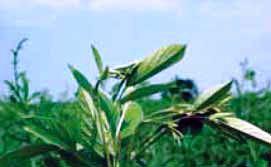 Egg: Adult female lays eggs on the leaf buds and young leaves.
Egg: Adult female lays eggs on the leaf buds and young leaves.- Larva: The larva is creamy-yellow in colour,
- Pupa: The fully-grown larvae pupate within web.
- Adult: The moth of G. critica is small brown in colour.
- Larvae often found binding leaves together and feeds on the chlorophyll while remaining inside the web.
- Leafl ets are webbed together with silk and the larva feeds within the web.
- As the web often includes the terminal bud, further growth of that shoot is prevented.
- Infestation starts at the seedling stage and may persist to the reproductive stage when the larvae feed inside flower buds and in young pods.
- If infestation starts at the seedling stage, the crop is severely affected and infestation remains throughout the crop season and may affect the flower buds also.
Blister beetle
The beetles are found to occur throughout the year in redgram, cowpea, green gram and black gram. Peak incidence is generally observed during September, causing a maximum flower damage of 95 per cent.
Biology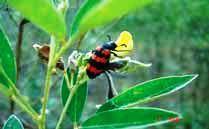 Egg: Adults lay eggs in the soil at the base of the plant.
Egg: Adults lay eggs in the soil at the base of the plant.- Larva: The immature stages (larvae) do not feed on plants. They live in the soil and eat grasshopper eggs, and are therefore beneficial.
- Pupa: The larva pupates in the soil.
- Adult: The adults are medium to large (2.5 cm in length), usually black with large yellow spots and a red band across the abdomen, which some times changes into yellow spots. The antennae are orange or yellow.
- Adults feed on the flowers, tender pods and young leaves resulting in fewer pods.
- In locations where pigeon pea is grown over large areas, blister beetles cause little damage.
- However, in small plots that are in the flowering stage during the period of peak adult activity (August-October in southern India), most of the flowers may be eaten by the beetles and crop losses may be substantial.
Plume moth
The pest is active throughout the year depending on the availability of the host plants. Apart from redgram, it is also recorded in horse gram and lablab.
Biology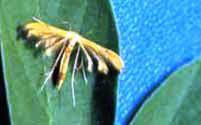 Egg: The female lays green oval eggs singly on buds and pods. Each female can lays 60 green coloured eggs on the tender developing pods. The egg period is 48-96 hours.
Egg: The female lays green oval eggs singly on buds and pods. Each female can lays 60 green coloured eggs on the tender developing pods. The egg period is 48-96 hours.- Larva: The larvae are green in colour with spine like hairs all over the body and are spindle shaped. The larva feeds on the developing parts/tender seeds.
- Pupa: The pupa which appear like a larva, is often found attached to the pod surface or on the pedicel.
- Adult: The plume moths usually appear at flowering time of the crop or sometimes in pre-flowering stage. The adults have brown, plume like wings. One generation can be completed in about 4 weeks.
Root-knot nematode
Biology- Most species of plant parasitic nematodes have a relatively simple life cycle consisting of the egg, four larval stages and the adult male and female.
- Development of the first stage larvae occurs within the egg where the first molt occurs. Second stage larvae hatch from eggs to find and infect plant roots or in some cases foliar tissues.
- Under suitable environmental conditions, the eggs hatch and new larvae emerge to complete the life cycle within 4 to 8 weeks depending on temperature.
- Nematode development is generally most rapid within an optimal soil temperature range of 70 to 80° F.
- Infected plants in patches in the field
- Formation of galls on host root system is the primary symptom
- Roots branch profusely starting from the gall tissue causing a ‘beard root’ symptom
- Infected roots become knobby and knotty
- In severely infected plants the root system is reduced and the rootlets are almost completely absent. The roots are seriously hampered in their function of uptake and transport of water and nutrients
- Plants wilt during the hot part of day, especially under dry conditions and are often stunted
- Nematode infection predisposes plants to fungal and bacterial root pathogens
- Primary: Egg masses in infected plant debris and soil or collateral and other hosts like Solonaceous, Malvaceous and Leguminaceous plants act as sources of inoculum.
- Secondary: Autonomous second stage juveniles that may also be water dispersed.
- Loamy light soils
IPM for Redgram
To know the IPM practices for Redgram, click here.
Source: NIPHM and Directorate of Plant Protection, Quarantine & Storage
Last Modified : 12/11/2019
This topic covers the information related to Pest ...
Natural enemies of Redgram insect pests are covere...
This topic covers the information related to Insec...
This topic covers the Information related to Disea...
